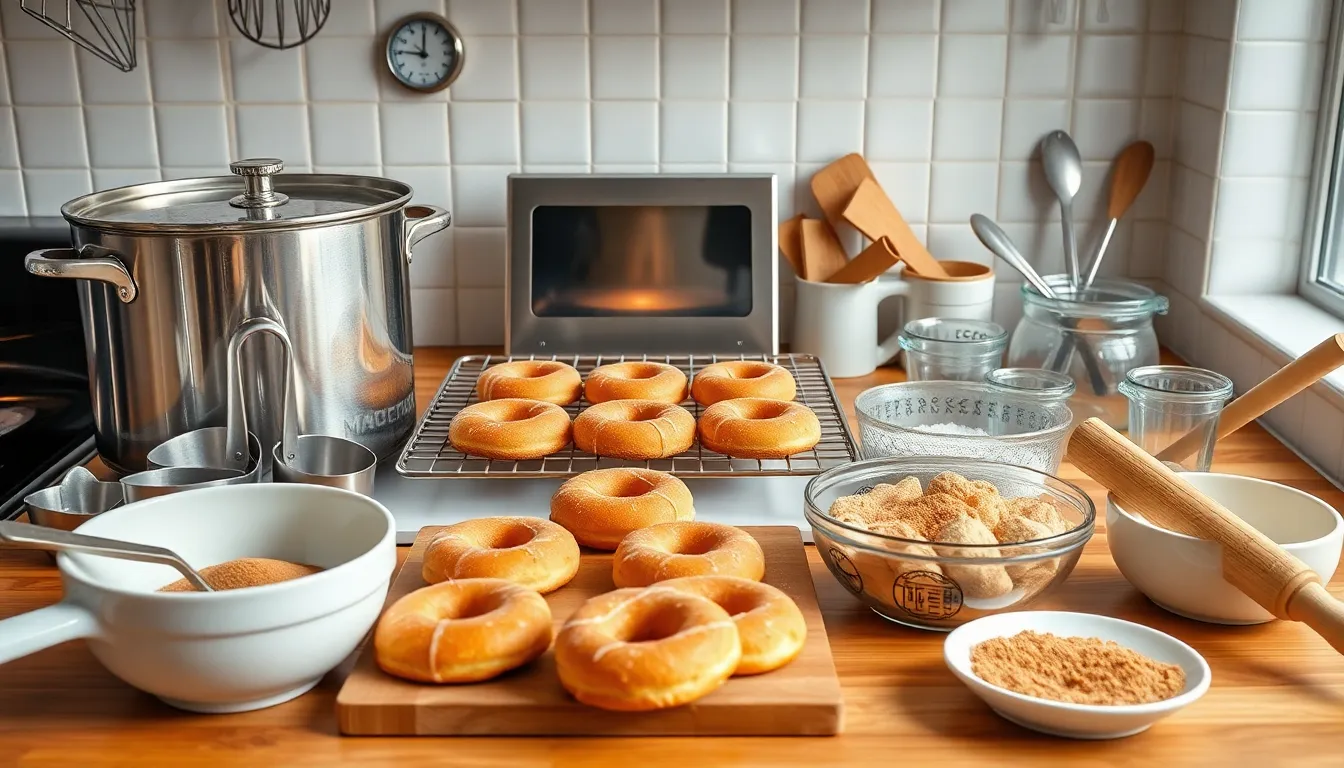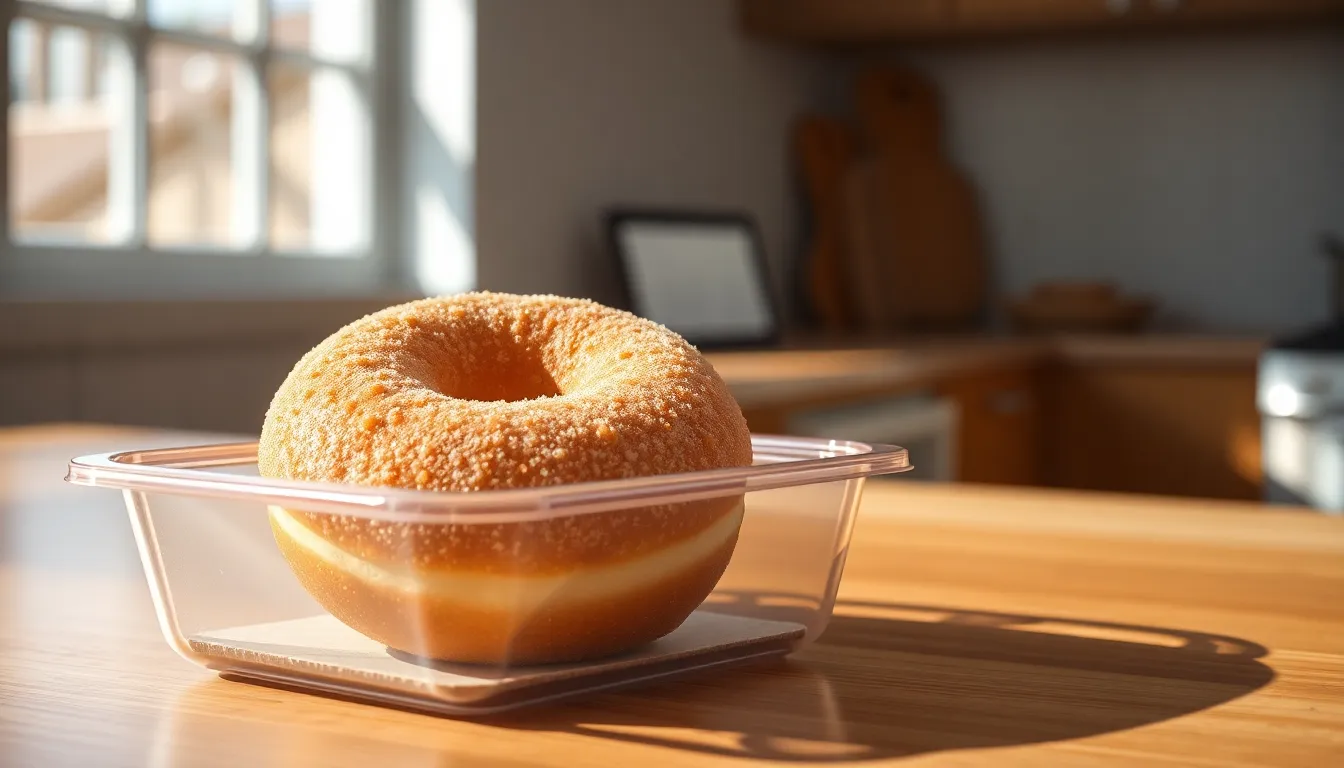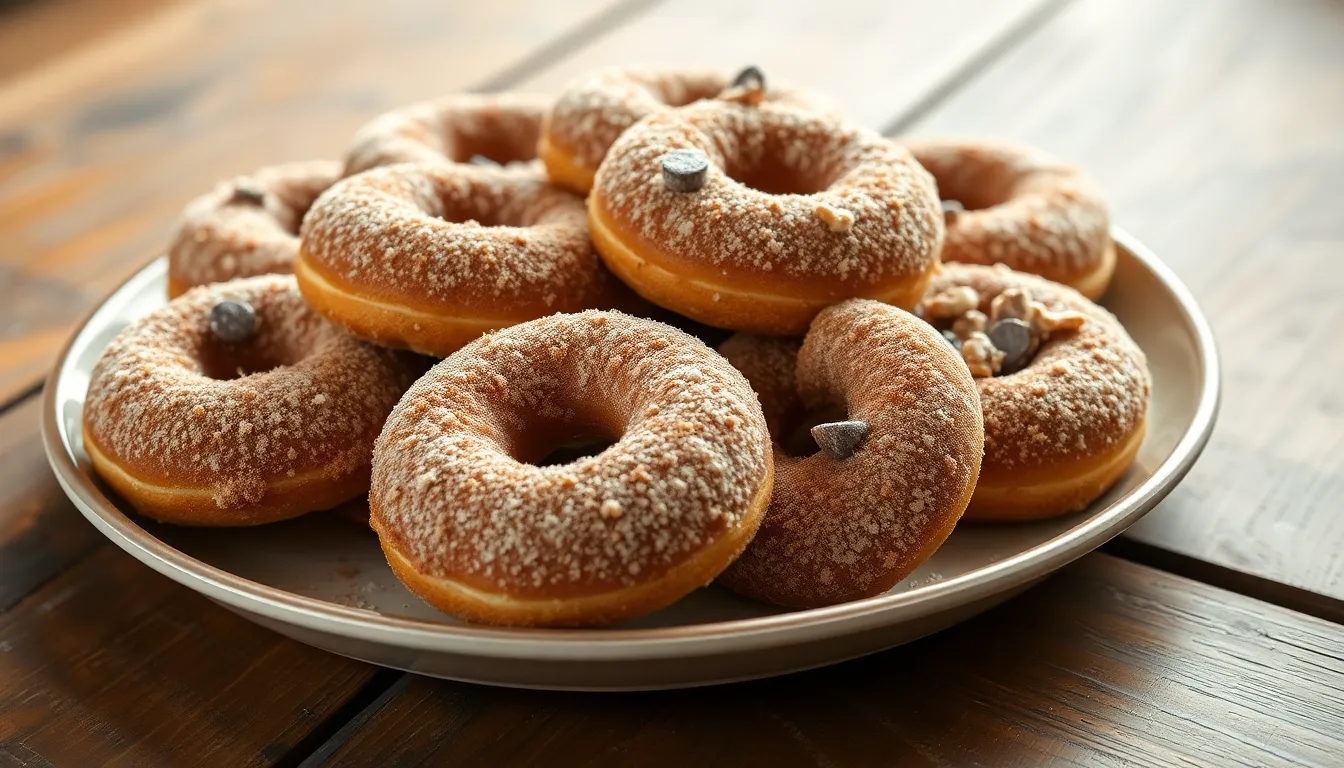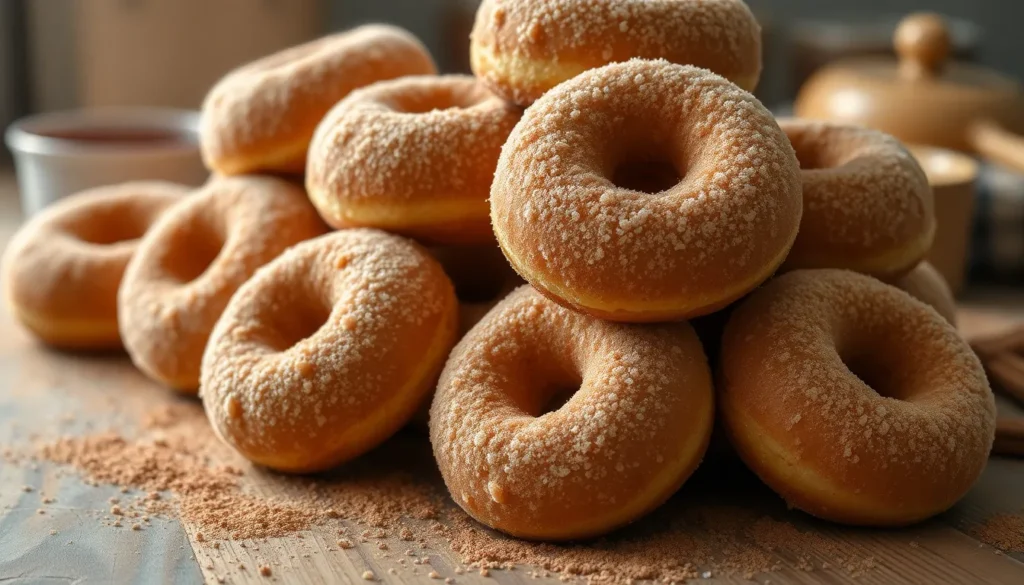Nothing beats the irresistible combination of warm donuts rolled in cinnamon sugar. These golden rings of joy transport us straight back to childhood memories of Saturday mornings and special treats. We’ve perfected this cinnamon sugar donut recipe that delivers bakery-quality results right from your own kitchen.
Our homemade version creates incredibly fluffy donuts with a tender crumb that’s miles ahead of store-bought alternatives. The secret lies in our carefully balanced dough that fries to perfection and creates the ideal canvas for that signature cinnamon sugar coating. Each bite delivers the perfect contrast between the crispy exterior and pillowy-soft interior.
Whether you’re planning a weekend brunch or craving a nostalgic comfort food moment, these donuts come together surprisingly quickly. We’ll walk you through every step to ensure your donuts turn out beautifully golden and absolutely delicious every single time.
Ingredients
We’ve carefully selected each ingredient to create donuts with the perfect texture and flavor balance. These simple pantry staples work together to deliver that irresistible combination of crispy exterior and fluffy interior.
For the Donuts
- 2 cups all-purpose flour
- 3/4 cup granulated sugar
- 2 teaspoons baking powder
- 1 teaspoon salt
- 1/2 teaspoon ground nutmeg
- 1/3 cup whole milk
- 2 large eggs (room temperature)
- 2 tablespoons unsalted butter (melted and cooled)
- 1 teaspoon vanilla extract
- Vegetable oil for frying (about 6 cups)
For the Cinnamon Sugar Coating
- 1/2 cup granulated sugar
- 1 tablespoon ground cinnamon
- 2 tablespoons unsalted butter (melted)
Equipment Needed

Creating perfect cinnamon sugar donuts requires the right tools to achieve consistent results and maintain safety while frying. We recommend gathering these essential pieces of equipment before starting your donut making adventure.
Heavy Bottom Pot or Dutch Oven serves as our primary frying vessel. The thick base distributes heat evenly and maintains stable oil temperatures throughout the cooking process. A 4 to 6 quart capacity works best for most home kitchens.
Deep Fry Thermometer ensures precise temperature control between 350°F and 375°F. Maintaining proper oil temperature prevents greasy donuts while achieving that golden brown exterior we all crave.
Donut Cutter or Biscuit Cutters shape our dough into perfect rings. Using a 3-inch cutter for the outer circle and a 1-inch cutter for the center hole creates traditional sized donuts. Cookie cutters work as suitable alternatives if dedicated donut cutters are unavailable.
Wire Cooling Rack allows excess oil to drain properly after frying. Placing the rack over a baking sheet catches dripping oil and keeps our workspace clean.
Slotted Spoon or Spider Strainer safely transfers donuts in and out of hot oil. The long handle keeps our hands away from dangerous splatter while the perforated design drains oil efficiently.
Large Mixing Bowl accommodates our dough mixing needs. Stainless steel or glass bowls work best as they do not retain odors or flavors from previous uses.
Measuring Cups and Spoons ensure accurate ingredient proportions. Digital kitchen scales provide even more precision for consistent results batch after batch.
Rolling Pin flattens our dough to the proper thickness of approximately half an inch. This uniform thickness ensures even cooking throughout each donut.
Shallow Dish or Pie Plate holds our cinnamon sugar coating mixture. The wide surface area makes coating warm donuts quick and effortless.
Instructions

Now that we have our ingredients and equipment ready, let’s walk through each step to create these irresistible homemade cinnamon sugar donuts. Follow these detailed instructions for perfectly fluffy donuts with a golden crispy exterior.
Prep the Ingredients
We begin by organizing all our ingredients for easy access during the cooking process. Measure the dry ingredients first: combine 2 cups all-purpose flour, 1 teaspoon baking powder, 1/2 teaspoon baking soda, 1/2 teaspoon salt, 1 teaspoon ground cinnamon, and 1/4 teaspoon nutmeg in a large bowl. Whisk these together thoroughly to ensure even distribution. Set aside this dry mixture while we prepare the wet ingredients. In a separate bowl, crack 2 large eggs and beat them lightly. Add 3/4 cup granulated sugar, 1/2 cup sour cream, and 1 teaspoon vanilla extract to the beaten eggs.
Make the Donut Batter
Creating the perfect donut batter requires gentle mixing to avoid tough donuts. Beat the wet ingredients together until the mixture becomes smooth and well combined. Gradually add the dry ingredient mixture to the wet ingredients, stirring just until the ingredients come together. Avoid overmixing the batter as this develops gluten and creates dense donuts. The finished batter should appear slightly sticky but manageable. Turn the dough onto a lightly floured surface and gently knead it 2-3 times to bring it together. Roll the dough to about 1/2 inch thickness using a rolling pin.
Heat the Oil
Pour vegetable oil into your heavy bottom pot or Dutch oven, filling it to a depth of 3-4 inches. Heat the oil over medium heat until it reaches exactly 375°F on your deep fry thermometer. Maintaining this temperature is crucial for properly cooked donuts that aren’t greasy. Test the oil temperature by dropping a small piece of dough into the oil; it should sizzle immediately and rise to the surface. Adjust the heat as needed throughout the frying process to maintain the 375°F temperature.
Fry the Donuts
Cut the rolled dough using a donut cutter or two round cutters of different sizes to create the classic donut shape. Save the donut holes for frying as well since they make delicious bite-sized treats. Carefully lower 2-3 donuts into the hot oil using a slotted spoon, being careful not to overcrowd the pot. Fry each donut for approximately 2 minutes on the first side until golden brown. Flip the donuts using your slotted spoon and fry for another 1-2 minutes on the second side. Remove the donuts when both sides achieve a beautiful golden brown color and place them on the wire cooling rack to drain excess oil.
Prepare the Cinnamon Sugar Coating
While the donuts are still warm, we prepare the irresistible cinnamon sugar coating. Combine 2/3 cup granulated sugar with 2 teaspoons ground cinnamon in a shallow dish. Mix these ingredients thoroughly to create an even distribution of cinnamon throughout the sugar. This coating mixture should have a fragrant aroma and uniform color when properly combined.
Coat the Donuts
Timing is essential for the best coating adherence, so we coat the donuts while they’re still warm from frying. Lightly brush each warm donut with melted butter if desired for extra coating adhesion. Roll each donut in the cinnamon sugar mixture, pressing gently to ensure the coating sticks to all surfaces. Shake off any excess sugar mixture and place the coated donuts on a clean plate or serving tray. The warm donuts will absorb the cinnamon sugar beautifully, creating that perfect sweet and spicy exterior we all crave.
Tips for Perfect Cinnamon Sugar Donuts

Mastering the art of cinnamon sugar donuts requires attention to detail and proper technique. We’ve compiled essential tips to help you achieve bakery-quality results every time.
Managing Your Dough for Fried Donuts
The soft texture of donut dough can be challenging to work with. We recommend chilling your dough in the refrigerator for at least 3 hours or overnight to make it more manageable. This cold fermentation process allows the yeast to work slowly while firming up the dough structure. Never leave the dough longer than 24 hours as yeast activity significantly decreases after this point.
Oil Temperature and Timing
Heat your frying oil before your donuts finish their second rise. Oil typically takes 15 to 20 minutes to reach the proper temperature of 375°F. Starting the heating process during the second rise prevents over-proofing and ensures your donuts maintain their perfect texture.
Creating the Perfect Cinnamon Sugar Ratio
We suggest using a 3:1 ratio of sugar to cinnamon for the coating mixture. This balance provides sweetness while allowing the warm spice notes to shine through. Dip your cooled donuts into this mixture immediately after frying for optimal coating adhesion.
Baked Donut Techniques
Fill a zip-top bag with batter and snip one corner to pipe directly into your donut pan. This method ensures even distribution and creates professional-looking donuts without mess. Adding Greek yogurt or sour cream to your batter enhances moisture content significantly.
Brown sugar works excellently as a sweetener in baked versions while contributing to the overall texture. Coat your donut pan thoroughly with non-stick spray to prevent sticking during the baking process.
Coating Baked Donuts Properly
Warm your baked donuts slightly before coating them. Brush melted butter over the surface first to help the cinnamon sugar mixture adhere better. This extra step creates a more even coating and prevents the mixture from falling off.
Storage and Preservation
Wrap cooled donuts individually in plastic wrap before freezing to maintain freshness. Thaw frozen donuts by microwaving for 20 seconds or allowing them to sit at room temperature. This method preserves the texture and prevents the donuts from becoming soggy.
| Timing Guidelines | Duration |
|---|---|
| Dough chilling time | 3-24 hours |
| Oil heating time | 15-20 minutes |
| Microwave thawing | 20 seconds |
Storage Instructions

Proper storage ensures our freshly baked cinnamon sugar donuts maintain their delightful texture and flavor for as long as possible. We recommend consuming these treats on the day they are baked for optimal freshness and taste.
Room Temperature Storage: We can store our cooled donuts in an airtight container at room temperature for up to 3 days. Always allow the donuts to cool completely before storing to prevent moisture accumulation, which leads to early spoilage and soggy texture.
Refrigerator Storage: For extended freshness, we place our donuts in an airtight container and refrigerate them for about one week. This method significantly extends their shelf life while maintaining quality.
Freezer Storage: Long-term storage becomes simple when we freeze our donuts in airtight containers or freezer bags for up to 2 months. Some sources indicate properly frozen donuts can last up to 6 months when stored correctly. We remove as much air as possible from the container before freezing to prevent freezer burn and maintain texture.
| Storage Method | Duration | Container Type |
|---|---|---|
| Room Temperature | Up to 3 days | Airtight container |
| Refrigerator | About 1 week | Airtight container |
| Freezer | Up to 2 months | Airtight container or freezer bag |
Thawing Instructions: We thaw frozen donuts overnight in the refrigerator or at room temperature before serving. This gradual thawing process helps restore their original texture and prevents condensation from forming on the surface.
Storage Container Tips: Airtight containers or ziplock bags work best for maintaining freshness and preventing our donuts from absorbing odors from other foods. We ensure containers are completely clean and dry before storing our treats to maximize their shelf life.
Variations and Substitutions

We love experimenting with our cinnamon sugar donut recipe to create exciting new flavors and accommodate different dietary needs. These versatile treats offer countless opportunities for customization while maintaining their beloved classic appeal.
Recipe Variations
Fried vs. Baked Options
We can prepare our donuts using two distinct methods that yield different textures and benefits. Fried donuts create a lighter and airier texture that many consider the gold standard for donut perfection. Baked donuts offer a healthier alternative that requires less oil and proves easier to manage in home kitchens.
Creative Toppings Beyond Cinnamon Sugar
While our classic cinnamon sugar coating remains irresistible, we encourage exploring other delicious toppings. Chocolate chips add rich sweetness that pairs beautifully with the tender donut base. Crushed nuts like pecans or almonds provide delightful texture contrast and nutty flavors. Different spice combinations such as cardamom sugar or chai spice blends create unique taste profiles that surprise and delight.
Flavor Enhancement Options
We can elevate our basic donut recipe by incorporating additional spices into the dough itself. Ground nutmeg adds warm complexity that complements the cinnamon perfectly. Cardamom brings an exotic floral note that transforms ordinary donuts into something special.
Smart Substitutions
Gluten Free Alternatives
We can easily adapt our recipe for gluten free diets by substituting all purpose flour with alternative options. Almond flour creates rich, nutty flavored donuts with excellent moisture retention. Rice flour produces lighter textured results that closely mimic traditional wheat based donuts.
Sugar Replacement Options
Natural sweeteners offer healthier alternatives without sacrificing taste. Honey provides subtle floral notes and keeps donuts moist longer than granulated sugar. Maple syrup adds complex caramel undertones that enhance the overall flavor profile. Stevia works well for those monitoring sugar intake while maintaining sweetness levels.
Egg Free Answers
Plant based egg replacers work exceptionally well in our donut recipes. Flaxseed mixed with water creates binding properties similar to eggs while adding beneficial omega fatty acids. Applesauce contributes moisture and subtle sweetness that enhances the final texture.
Dairy Free Modifications
Non dairy milk alternatives seamlessly replace regular milk without compromising taste or texture. Almond milk provides neutral flavor that lets other ingredients shine. Coconut milk adds richness and subtle tropical notes that pair wonderfully with cinnamon spicing.
Coating Ratio Guidelines
Our tested cinnamon sugar coating uses a precise 3:1 ratio of sugar to cinnamon for optimal flavor balance. This proportion ensures adequate sweetness while allowing the warm cinnamon spice to shine through each bite.
| Ingredient | Standard Recipe | Large Batch |
|---|---|---|
| Granulated Sugar | 3 tablespoons | 6 tablespoons |
| Ground Cinnamon | 1 tablespoon | 2 tablespoons |
These variations and substitutions allow us to customize our cinnamon sugar donuts for any occasion or dietary preference while maintaining the beloved characteristics that make these treats so special.
Conclusion
We’ve shared everything you need to create bakery-quality cinnamon sugar donuts in your own kitchen. These homemade treats offer that perfect combination of crispy exterior and fluffy interior that simply can’t be matched by store-bought alternatives.
The beauty of this recipe lies in its simplicity and flexibility. Whether you choose the traditional fried method or opt for the healthier baked version you’ll achieve consistently delicious results every time.
With proper storage techniques and our suggested variations you can customize these donuts to suit any dietary preference or flavor craving. The key is maintaining that essential 3:1 sugar-to-cinnamon ratio that makes these treats irresistible.
Now it’s time to roll up your sleeves gather your ingredients and start creating these memorable homemade donuts that’ll fill your kitchen with warmth and incredible aromas.
Frequently Asked Questions
What temperature should the oil be for frying donuts?
Heat the oil to 375°F for optimal frying results. This temperature ensures the donuts cook evenly with a golden-brown exterior and fluffy interior. Use a deep fry thermometer for accurate temperature control, as oil that’s too hot will burn the outside while leaving the inside undercooked.
How long can homemade cinnamon sugar donuts be stored?
Fresh donuts are best consumed the same day for optimal taste and texture. However, you can store them at room temperature for up to 3 days, refrigerate for about a week, or freeze for up to 2 months. Use airtight containers to maintain freshness and prevent spoilage.
What’s the best sugar to cinnamon ratio for coating donuts?
The ideal ratio is 3:1 sugar to cinnamon for the perfect coating. This proportion provides the right balance of sweetness and spice without overwhelming the donut’s flavor. Mix granulated sugar with ground cinnamon and coat the warm donuts for best adhesion.
Can I make baked donuts instead of fried ones?
Yes, you can make baked versions by piping the batter into a donut pan and baking until golden. Add Greek yogurt to the batter for extra moisture in baked donuts. While the texture differs slightly from fried donuts, they’re still delicious and healthier.
Should I chill the donut dough before frying?
Chilling the dough for 3 hours to overnight improves manageability and helps achieve better texture. Cold dough is easier to roll and cut, resulting in more uniform donuts. This step also helps prevent the dough from absorbing too much oil during frying.
What equipment do I need to make homemade donuts?
Essential equipment includes a heavy-bottom pot or Dutch oven, deep fry thermometer, donut or biscuit cutters, wire cooling rack, slotted spoon, mixing bowls, measuring tools, rolling pin, and a shallow dish for coating. These tools ensure safe frying and consistent results.
Can I make gluten-free or dairy-free donuts?
Yes, the recipe can be adapted for various dietary needs. Use gluten-free flour blends for gluten-free versions, substitute plant-based milk and vegan butter for dairy-free options, and explore egg substitutes if needed. Adjust liquid ratios as necessary for proper consistency.
How do I prevent donuts from becoming greasy?
Maintain proper oil temperature at 375°F and avoid overcrowding the pot. Use a wire cooling rack to drain excess oil immediately after frying. Don’t skip the thermometer, as incorrect temperature is the main cause of greasy donuts.







